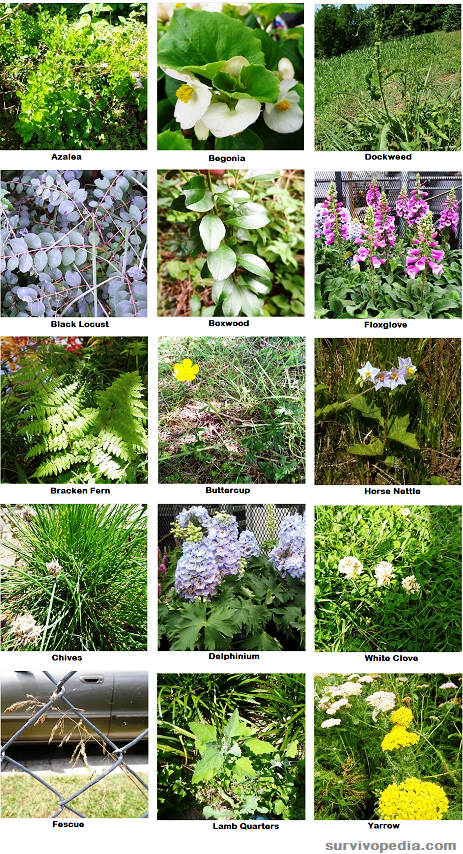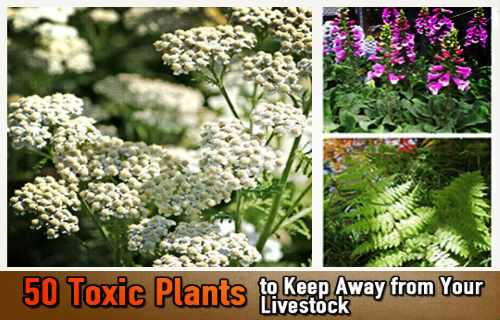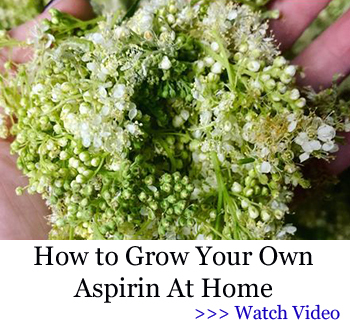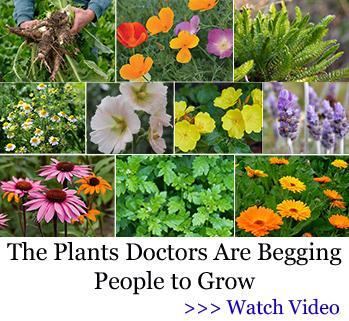Once you buy enough land to support a survival farm and choose the kinds of animals that will live on it, you will still have a long way to go before creating a viable and sustainable farm. Unfortunately, many people that create survival farms fail to realize that toxic plants can easily wipe out all animals on the farm, or make milk and other products inedible.
In order to prevent this from happening, you should be aware of plants that are poisonous or harmful to animals you plan on keeping as well as make sure you understand how they get introduced into your grazing areas.
Common Ways Toxic Plants Get Introduced to Grazing Areas
Surprisingly enough, some of the most toxic plants to livestock come straight from the nursery. This includes herbs, flowers, fruits, and even vegetables that you may decide to grow for food, medicine, or landscaping purposes.
If you visit the local plant nursery, you are sure to be surprised to find many plants and seeds are available for vegetation that does not naturally grow in your area. Some natural perennials may grow as annuals or biennials in your area.
In other situations, the plants you buy may actually turn into an invasive species.
No matter how long these plants grow in your area, they will still be poisonous to livestock. See below the list of the most common 50 plants to avoid when feeding your farm animals, in order to keep them healthy and safe.

Securing Grazing Land from Toxic Plants
If you are determined to grow these plants, then be sure they will be located in an area where livestock cannot get to them.
In addition, some plants have pollen that can contaminate water and other resources. This exposure can be fatal to sensitive animals without you even realizing where the problem came from.
Therefore, you may want to isolate these plants in a greenhouse or take other measures to prevent these plants from coming into contact with livestock.

Keeping Grazing Areas Free of Toxic Plants
Aside from avoiding plants that may harm livestock, there are many native plants or weeds that will need to be removed from grazing areas. You can use a combination of four methods to eliminate toxic plants from pastures:
- Use herbicides that will not harm livestock. Most commercial herbicides will only get rid of specific species of plants. You can just as easily use a mixture of vinegar and dish detergent on a hot sunny day and spray it just on plants to be eliminated.
- Manually uproot plants and burn them in an area where smoke filled with plant oils will not get near livestock or human living areas.
- Look for plant species that will crowd out poisonous plants or prevent them from thriving. Essentially this is the opposite of companion planting for your garden.
- Make the soil as inhospitable as possible to poison plants by altering the pH or other methods. Just be sure that grass or other intended pasture plants can grow in the area and provide proper nutrition for livestock.
-
-
With your seeds kit, you’ll also receive a FREE Medicinal Guide that shows you how to turn these 10 plants into tinctures, ointments, salves, poultices, decoctions, infusions, essential oils —all in minute detail so you can follow our guide even if you’ve never made an herbal medicine in your life.
Symptoms of Poisoning in Livestock by Most Common Toxin Types and Treatment
No matter how hard you try, there are going to be a few poisonous plants that slip into pasture lands. In most cases, the animal may be sick for several days before making a full recovery.
Unfortunately, there are also some plants that are so toxic just a few berries or leaves will kill an animal within hours.
It is very important to realize that the following emergency treatment methods may still fail even if the animal does not look very sick. The amount of toxin consumed, emptiness or fullness of stomach at time of ingestion, and many other factors will contribute to success or failure of treatment.
The emergency treatments in the following chart is based on the general class of poison. Many plants have specific toxins within each category that may require additional or specialized treatment. But there are hundreds of poisonous plants and also hundreds of chemicals that are well beyond discussion here. You can contact poison control centers and find out more about specific treatments if you so choose.
That being said, in a crisis situation these resources may not be available. In that case, perhaps it can be said that trying these generalized remedies is better than not trying anything at all.
In order to determine which plant poisoned livestock, you can look at material vomited for bits of plant material, take note of breath odor, and also look in the area for plants with signs of chewing on them.
Toxins, Symptoms and Basic Treatments
Alkaloid
- Symptoms of poisoning: Diarrhea, vomit, weakness, collapse, fever, confusion, muscle twitching, apparent blindness, nervous walking, drooling.
- Basic treatment: Alkaloid poisoning can occur over a period of days or more quickly depending on amount consumed. It is best to isolate the animal and see if it recovers; however it will usually be more prone to disease and stunted growth. For scopolamine and atropine poisoning, try giving vinegar orally since it is an acid that can help lower pH.
Glycoalkoid
- Symptoms of poisoning: Vomit, diarrhea, dizziness, dilated pupils, paralysis, fever, hypothermia.
- Basic treatment: If animal has diarrhea, allow to continue until toxin is flushed out. Watch for dehydration and try to prevent. If no diarrhea, try to induce vomiting as a last resort.
Glycoside
- Symptoms of poisoning: Muscle tremors, seizures, rapid breathing, vomiting, diarrhea, colic.
- Basic treatment: Some poisons in this class can kill in minutes and with very little exposure. For cattle and horses, feed activated charcoal at 2 grams per 2 -3 kg of body weight (or some say 1 – 3 grams per kg). The charcoal will absorb any poison that has not yet gotten into the bloodstream. Induce vomiting in species where vomiting is possible.
Lecitin
- Symptoms of poisoning: Panting, rapid heartbeat, bright red mucus membranes. In later stages, mucus membranes and skin will turn pale and temperature decreases
- Basic treatment: Epinephrine injection if available – you will need to find out how much to use based on animal’s weight. Administer IV fluids to keep blood pressure up
Mycotoxin
- Symptoms of poisoning: Lack of appetite, dark stool, low milk production, increased risk of infections. Short term symptoms include vomit, tremors, weakness, fever, increased heart rate, dehydration, seizure.
- Basic treatment: Eliminate moldy foods from feeding areas, prevent grazing in pastures where mold or fungi are present. Induce vomiting if appropriate for species, then administer activated charcoal. Use anti-seizure medication if available based on animal weight. IV fluids may also help if animal is in shock.
Nitrates
- Symptoms of poisoning: Trembling, rapid breathing, difficulty walking or moving. If the poisoning is over long periods of time, cattle may abort, also poor growth and low milk production. To avoid nitrate poisoning in usually safe plants, do not use ammonium sulfate or urea (usually derived from urine) as a fertilizer source.
- Basic treatment: Isolate animal from foods that may contain nitrates. Administer Methylene Blue (usually available in tropical fish supply stores) via IV. It may require several doses. Methylene Blue is very irritating to skin; so cannot be administered orally. Note – these animals may no longer be fit for human consumption.
Oxalates
- Symptoms of poisoning: Mouth pain, swollen tongue or lips, increased salivation, throat swelling, drooling.
- Basic treatment: Keep airway open, use antihistamines if available and safe for species being treated.
Phenols
- Symptoms of poisoning: Burns around or in mouth, vomit, diarrhea, seizures, and sweating, rapid heartbeat.
- Basic treatment: Make sure you are wearing garments and gloves that reduce risk of exposure to phenols since they are easily absorbed through skin and via air. Try to induce vomit and then administer activated charcoal to absorb any poison remaining. If possible, intubate the animal and use CPR for animals. Usually there is no cure for phenol poisoning.
When it comes to raising animals on a farm, many people do not realize how many toxic plants exist in nature, let alone ones that can be introduced to satisfy other interests. In addition, the types of poisons and their treatment can be very complicated.
That said, if you notice an animal with symptoms of poisoning, you can try a few things to keep the animal alive and help it to recover.
Books can be your best pre-collapse investment.
Easy Cellar(Info about building and managing your root cellar, plus printable plans. The book on building and using root cellars – The Complete Root Cellar Book.)
The Lost Ways (Learn the long forgotten secrets that helped our forefathers survive famines,wars,economic crisis and anything else life threw at them)
LOST WAYS 2 ( Word of the day: Prepare! And do it the old fashion way, like our fore-fathers did it and succeed long before us, because what lies ahead of us will require all the help we can get. Watch this video and learn the 3 skills that ensured our ancestors survival in hard times of famine and war.)
This article has been written by Carmella Tyrell for Survivopedia.com.




